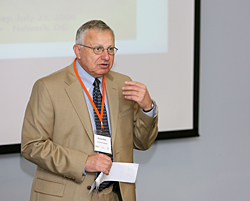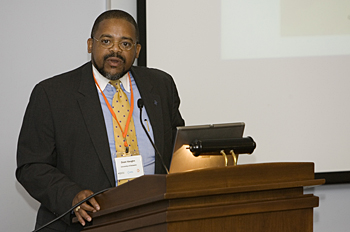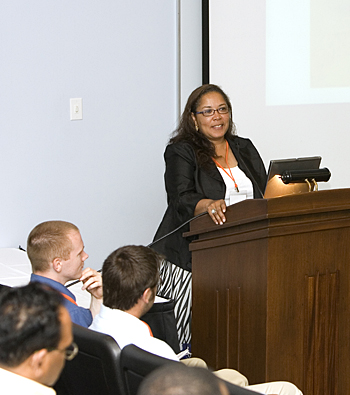
Now in its second year at UD, the four-day event, which runs through Wednesday, is a team effort between the University's National Science Foundation-sponsored Sustainable Energy from Solar Hydrogen Integrative Graduate Education and Research Traineeship (IGERT) program and the National Renewable Energy Laboratory's (NREL) Minority Undergraduate Research Associates (MURA) Program. Together IGERT and MURA aim to give engineering undergraduates opportunities to present their work, network with others and learn from experts who are active in the field of solar hydrogen.
Among those speaking Monday morning were Michael Vaughan, senior assistant dean of engineering; Christiana Honsberg, associate professor of electrical and computer engineering; Dan Rich, University Provost; and doctoral-level students John Clinger and Keith Douglass. Guests Fannie Posey-Eddy, NREL-MURA project leader, and Syl Morgan Smith, manager of diversity and community outreach in the NREL public relations center, also spoke.
“We have a great commitment as an undergraduate research institution to undergraduate research,” Rich said in his opening remarks, “and we're able to do what we do because of our partnerships with others.
“The University of Delaware was engaged in solar energy research and education long before it was 'cool,' going back into the '60s and into the '70s, with the creation of the Institute of Energy Conversion in 1972,” he said. “All through this time, it became one of the focal points on campus, and our commitment to this work is very deep and very broad still. The president of this University has affirmed it as one of his strategic initiatives, and on Sept. 19, we'll announce the establishment of the University Institute of Alternative Energy, an umbrella structure that will enrich all the other organizations that are underway across campus.”
Vaughan took the podium next, thanking students and faculty present for their work and commitment to their own projects.“You're involved every day in exciting research that changes lives and changes society and our world,” Vaughan said. “I encourage you to keep doing what you're doing, because it's important work that needs to be done, and I encourage you also to give something back. There are plenty of ways you can make connections and improvements in your own sphere of influence, and there are still new frontiers of knowledge to explore. Put your ideas out there and engage with colleagues, because that is what fuels innovation.”
Honsberg capped the morning session by giving a brief overview of the IGERT program at UD and by addressing the importance of using scientific research to better the world.
“This is a student-run conference, and I think it's clear from the level of commitment here that our students are well on their way to making a difference,” Honsberg said. “This workshop also gives them a chance to learn from others, and that's important, because the days of sitting alone in a lab doing research are pretty much over.
“The IGERT program is a National Science Foundation initiative, and its goal is to develop students in interdisciplinary areas, of which energy is certainly one,” Honsberg said, “and our IGERT program at UD focuses on solar hydrogen. This is very broadly defined as taking input from the sun and converting it back in some form to hydrogen.”
Honsberg used the measurement of height to illustrate the field's potential, comparing the world's current energy demand to the size of a human and available solar resources to the size of the Empire State Building. “Hydrogen is unique in that it offers a way to address all parts of the energy problem, including storage and generation, so there are real opportunities,” she said.Approximately 50 undergraduates from nine institutions of higher learning, including UD, are attending the workshop, where they will give brief poster presentations on their research, take tours of the Institute of Energy Conversion, and learn from peers, professors and scientists about ways of using sunlight to produce hydrogen.
Article by Becca Hutchinson
Photos by Kathy Atkinson



